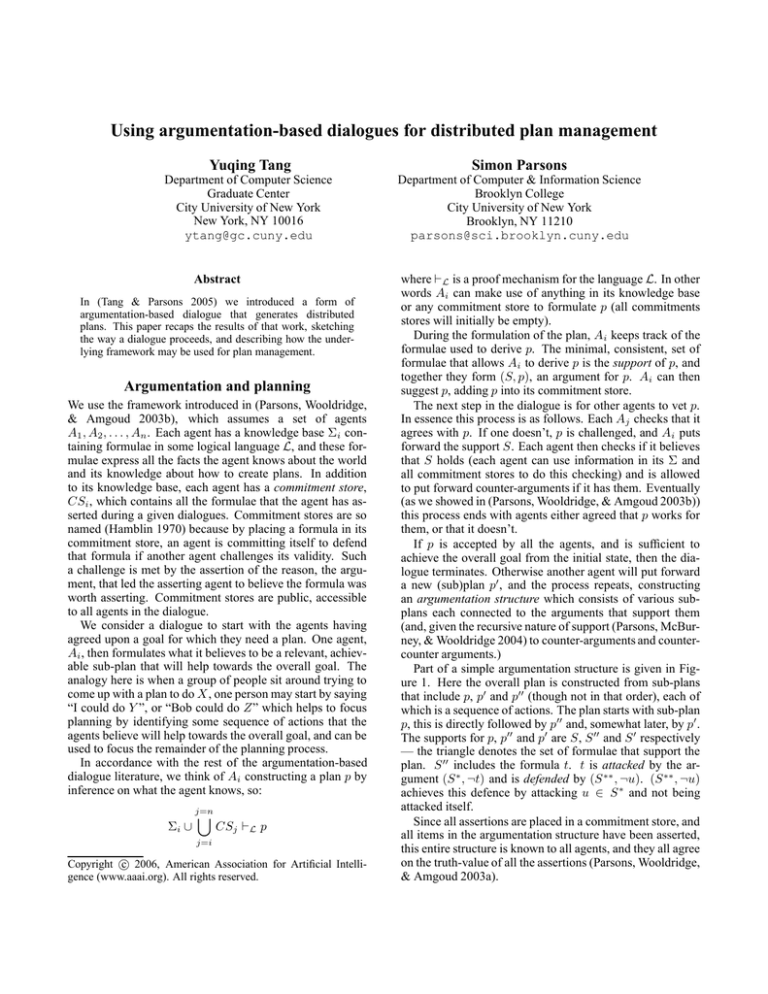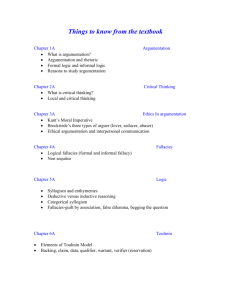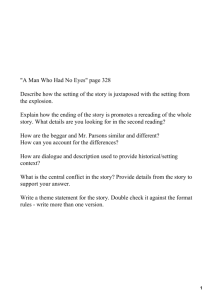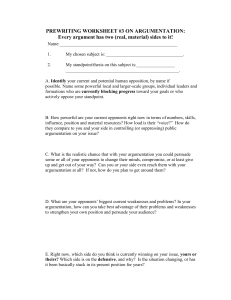
Using argumentation-based dialogues for distributed plan management
Yuqing Tang
Simon Parsons
Department of Computer Science
Graduate Center
City University of New York
New York, NY 10016
ytang@gc.cuny.edu
Department of Computer & Information Science
Brooklyn College
City University of New York
Brooklyn, NY 11210
parsons@sci.brooklyn.cuny.edu
Abstract
In (Tang & Parsons 2005) we introduced a form of
argumentation-based dialogue that generates distributed
plans. This paper recaps the results of that work, sketching
the way a dialogue proceeds, and describing how the underlying framework may be used for plan management.
Argumentation and planning
We use the framework introduced in (Parsons, Wooldridge,
& Amgoud 2003b), which assumes a set of agents
A1 , A2 , . . . , An . Each agent has a knowledge base Σi containing formulae in some logical language L, and these formulae express all the facts the agent knows about the world
and its knowledge about how to create plans. In addition
to its knowledge base, each agent has a commitment store,
CSi , which contains all the formulae that the agent has asserted during a given dialogues. Commitment stores are so
named (Hamblin 1970) because by placing a formula in its
commitment store, an agent is committing itself to defend
that formula if another agent challenges its validity. Such
a challenge is met by the assertion of the reason, the argument, that led the asserting agent to believe the formula was
worth asserting. Commitment stores are public, accessible
to all agents in the dialogue.
We consider a dialogue to start with the agents having
agreed upon a goal for which they need a plan. One agent,
Ai , then formulates what it believes to be a relevant, achievable sub-plan that will help towards the overall goal. The
analogy here is when a group of people sit around trying to
come up with a plan to do X, one person may start by saying
“I could do Y ”, or “Bob could do Z” which helps to focus
planning by identifying some sequence of actions that the
agents believe will help towards the overall goal, and can be
used to focus the remainder of the planning process.
In accordance with the rest of the argumentation-based
dialogue literature, we think of Ai constructing a plan p by
inference on what the agent knows, so:
Σi ∪
j=n
[
CSj `L p
j=i
c 2006, American Association for Artificial IntelliCopyright gence (www.aaai.org). All rights reserved.
where `L is a proof mechanism for the language L. In other
words Ai can make use of anything in its knowledge base
or any commitment store to formulate p (all commitments
stores will initially be empty).
During the formulation of the plan, Ai keeps track of the
formulae used to derive p. The minimal, consistent, set of
formulae that allows Ai to derive p is the support of p, and
together they form (S, p), an argument for p. Ai can then
suggest p, adding p into its commitment store.
The next step in the dialogue is for other agents to vet p.
In essence this process is as follows. Each Aj checks that it
agrees with p. If one doesn’t, p is challenged, and Ai puts
forward the support S. Each agent then checks if it believes
that S holds (each agent can use information in its Σ and
all commitment stores to do this checking) and is allowed
to put forward counter-arguments if it has them. Eventually
(as we showed in (Parsons, Wooldridge, & Amgoud 2003b))
this process ends with agents either agreed that p works for
them, or that it doesn’t.
If p is accepted by all the agents, and is sufficient to
achieve the overall goal from the initial state, then the dialogue terminates. Otherwise another agent will put forward
a new (sub)plan p0 , and the process repeats, constructing
an argumentation structure which consists of various subplans each connected to the arguments that support them
(and, given the recursive nature of support (Parsons, McBurney, & Wooldridge 2004) to counter-arguments and countercounter arguments.)
Part of a simple argumentation structure is given in Figure 1. Here the overall plan is constructed from sub-plans
that include p, p0 and p00 (though not in that order), each of
which is a sequence of actions. The plan starts with sub-plan
p, this is directly followed by p00 and, somewhat later, by p0 .
The supports for p, p00 and p0 are S, S 00 and S 0 respectively
— the triangle denotes the set of formulae that support the
plan. S 00 includes the formula t. t is attacked by the argument (S ∗ , ¬t) and is defended by (S ∗∗ , ¬u). (S ∗∗ , ¬u)
achieves this defence by attacking u ∈ S ∗ and not being
attacked itself.
Since all assertions are placed in a commitment store, and
all items in the argumentation structure have been asserted,
this entire structure is known to all agents, and they all agree
on the truth-value of all the assertions (Parsons, Wooldridge,
& Amgoud 2003a).
LL
L
S L
p0
p00
p
z }| {
[ai , . . . , an ]
L
z
}|
{
[ak , . . . , ap ] . . .
}|
{
z
[aj , . . . , am ] . . .
LL
L
S 00 L
L
.t
...
....
¬t
LL
L
S∗ L
u L
J
J
¬u
LL
∗∗L
S L
r
L
LL
L
S0 L
plan. In particular, if q contradicts one of the facts r in the
argumentation structure, then
j=n
[
CSj 6`L ¬r
Σi ∪
j=i
L
(if this were not the case then Ai would not have been able
to agree to the plan in the first place) but
j=n
[
Σi ∪
CSj ∪ {q} `L ¬r
j=i
.
Figure 1: Part of an argumentation structure — see text for
denotation.
Plan management
We consider plan management to be the activity that, given a
plan P (itself a sequence of subplans p, p00 , p0 , . . .) to achieve
a goal g, ensures that there is always a plan P 0 to achieve g
until g is achieved or deemed unachievable. In other words,
while planning is a one-shot process to construct a plan, plan
management is an ongoing process that is concerned with
making sure that a given outcome remains attainable.
From this perspective, the initial plan, P , is almost incidental. Typically, we don’t care if the plan remains the same
— though there may be costs involved if the plan is changed
arbitrarily — so long as we have a plan that does what we
need it to. Thus one, extreme, form of plan management is
to simply re-plan if, for example, the environment changes
so that P becomes impractical. This approach seems extreme, because it can be the case that a perfectly good new
plan, P 0 , can be found by making a minor change to P , and
establishing what such changes are and carrying them out
will be much less costly than replanning. Establishing these
kinds of modification is particularly straightforward with a
plan that is the result of an argumentation process precisely
because of the dependencies established during plan formation. Indeed, the dependency information is useful even before embarking on this part of plan management — the dependencies also help us in determining that there is a problem with the initial plan P .
To see why this is the case, let’s consider what happens
when one of the agents involved in constructing P , agent
Ai , learns something new about its environment. On perceiving a new fact q about the environment, Ai adds it to its
knowledge base Σi . If q is something that has a detrimental effect on the ability of the group of agents to carry out
P , then it will be possible for Ai to detect the threat to the
and so the structure can be used to check for problems.
In addition, the argumentation structure can be used to
identify how the plan can be fixed in order to take account
of q. To do this we need to circumvent r, the fact that q demolishes, and the argumentation structure tells us how to do
this. If r is in the support of some argument at the periphery
of the structure (as it is in Figure 1), then the first thing to try
is to find an alternative support for the conclusion of the argument ¬u. If this fails then a whole new argument must be
sought, and this may have a knock-on effect on whatever the
argument connects to in the argumentation structure. For example, if it is not possible to find a new argument in support
of ¬u, then it is necessary to either find an argument that
attacks another formula in S ∗ , or find an alternative support
for p00 , or an alternative sub-plan that achieves the same transitions as p00 . If this fails, it may be necessary to construct a
new overall plan to replace P .
Whatever is required, the structure makes it clear to all
agents which parts need to be replaced or rebuilt in order to
rehabilitate the plan (and, in the worst case, make it clear to
all agents that the entire plan must be replaced)
The reconstruction of the argumentation structure can, of
course, be carried out using precisely the same procedure
as was used to build the structure in the first place — the
recursive nature of that process means that it works just as
well for rebuilding a small section of the structure as it does
for constructing the whole thing.
References
Hamblin, C. L. 1970. Fallacies. London, UK: Methuen
and Co Ltd.
Parsons, S.; McBurney, P.; and Wooldridge, M. 2004.
Some preliminary steps towards a meta-theory for formal
inter-agent dialogues. In Rahwan, I., ed., Proceedings of
the 1st International Workshop on Argumentation in Multiagent Systems.
Parsons, S.; Wooldridge, M.; and Amgoud, L. 2003a. On
the outcomes of formal inter-agent dialogues. In 2nd International Conference on Autonomous Agents and MultiAgent Systems. ACM Press.
Parsons, S.; Wooldridge, M.; and Amgoud, L. 2003b.
Properties and complexity of formal inter-agent dialogues.
Journal of Logic and Computation 13(3):347–376.
Tang, Y., and Parsons, S. 2005. Argumentation-based dialogues for deliberation. In Proceedings of the 4th International Conference on Autonomous Agents and Multi-Agent
Systems. ACM Press.





